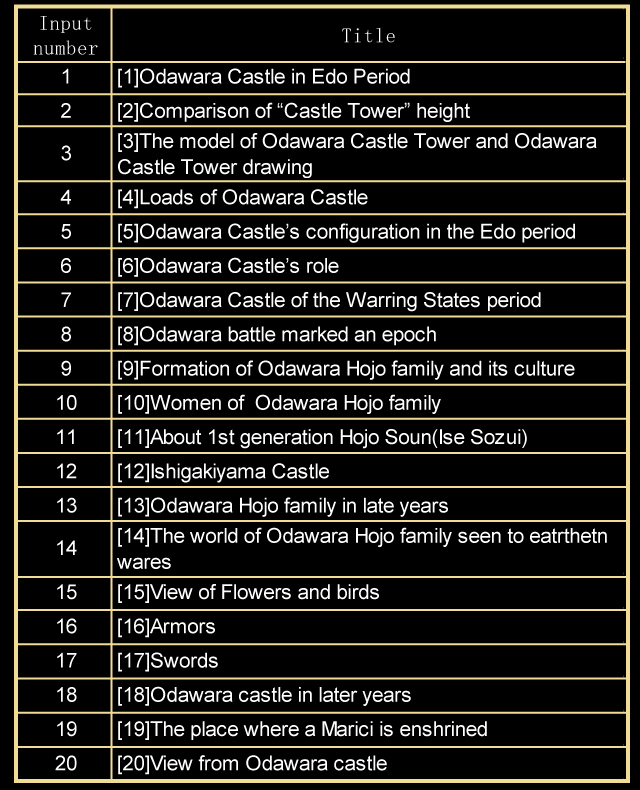
タグ: en
[20] View from Odawara Castle

In the west, you can see the hill of Hakone which was shaped by the Hakone volcano. Ten mountains of Hakone were worshipped together with the seven buddhist statues of the castle tower. Also, you can see Izu Oshima island in the south, and from the east to north, Boso peninsula, Miura peninsula and the mountains of Tanzawa can be seen.
[19] The place where Marishiten is enshrined

Seven buddhist statues including Marishiten were placed in the castle tower in the Edo period. After the survey of the model of the Odawara Castle tower, a room to place the Marishiten statue was found on the upper most floor. In this renovation construction, a room for the Marishiten was reconstructed by Odawara’s craftsman with Odawara’s wood.
[18] Odawara Castle in late years

Odawara castle was abandoned after the Meiji Restoration. After being under the jurisdiction of the Ministry of the Army and the Imperial Household Ministry, it became the land of Kanagawa Pref. and Odawara City. The use of the land also changed, and nowadays it is a castle site park.
[17] Swords

There was a sword maker called “Odawara Soshu” in the sengoku period. Tsunahiro, Tsunaie, and Yasuharu were famous sword makers, and Yoshisuke was their master. There are numerous swords in Odawara castle, and some are displayed in Samurai Gallery in Tokiwagi gate.
[16] Armor

This armor has been handed down from the Kawachi Sayama Hojo family. It is thought to be made in the end of the sengoku period from it’s decorations.
[15] View of Flowers and Birds

This painting was known as a Sugido-e (painting on cedar-board doors) painted by Okamoto Shuuki that decorated the main entrance of the Ninomaru palace. There are 4 motifs, a peafowl with a rock, a bird with mulberry wood, a carp with a pine tree and wisteria flowers, and plum blossoms. High techniques, for example, representing the wooden grain as a water surface shown in the motif of a carp with a pine tree and wisteria flowers are used in this painting.
[14] The world of Odawara Hojo family seen through earthen wares

Kawarake is an earthen clay pottery which was used in ritual ceremonies and feasts. Kawarake made in the Kanto area is mostly wheel made, but Odawara Hojo family used hand made kawarake, which was made with techniques used in Kyoto. These hand made kawarake were important good as the “Odawaramono” in their territory.
[13] Odawara Hojo family in late years

After the Odawara battle, busho (samurai warriors) who gathered headed home to their country and started to maintain and develop their land. Some of the fortifications followed the style of Odawara, because of the high defensiveness which was shown in the Odawara battle. Odoi (Kyoto), Okayama castle, and Sunpu castle are the representative examples.
[12] Ishigakiyama Castle

On April 6th 1590, Toyotomi Hideyoshi who built a base in Hakone Sounji temple, ordered to built a castle in Kasagakeyama. Then he made his people cut down the tree around the mountain, and moved his base on June 26th. The construction of this castle took only 82 days, and it appeared as if it was built in one night, so it became to be called “Ishigakiyama Ichiyajyo (a castle built in one night)”.